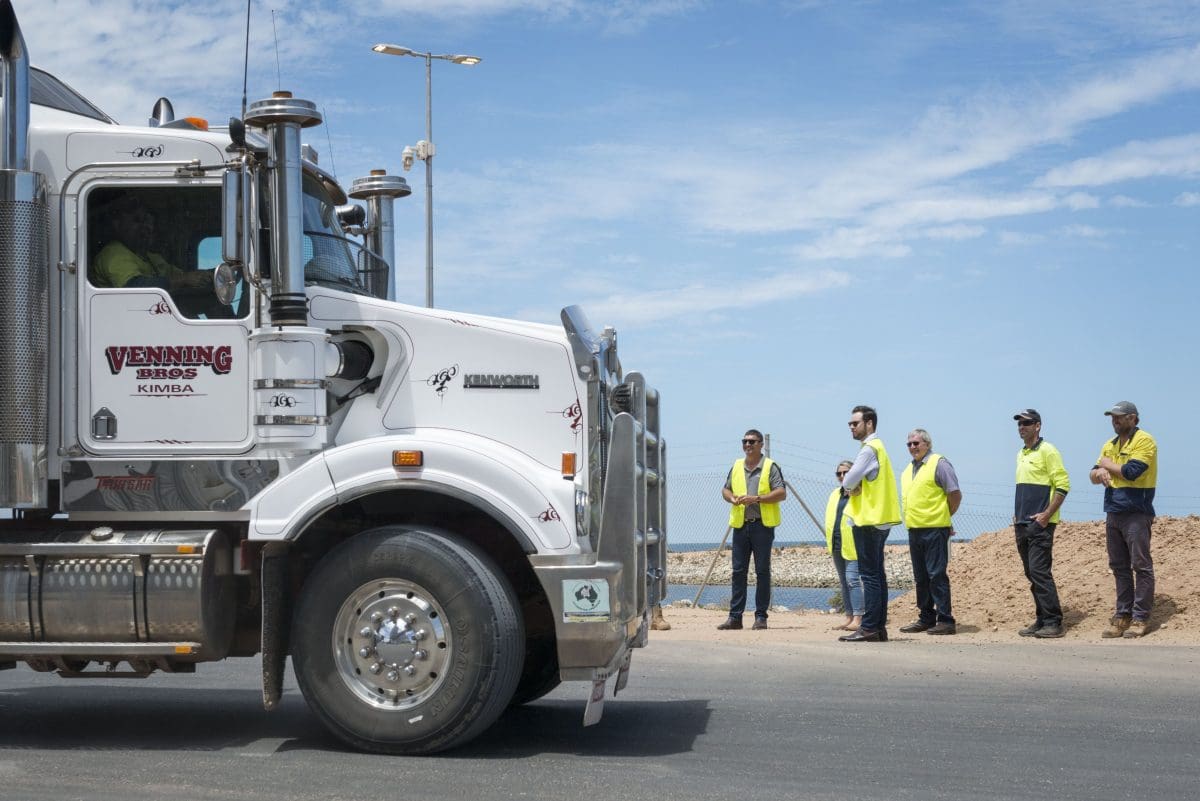
T-Ports facility at Lucky Bay in South Australia is exporting wheat as well as barley from the current harvest. Photo: T-Ports
PRICES for wheat, barley and sorghum in the domestic market have eased in the past week as supply-side pressure from the sorghum harvest now taking place and logistics constraints weigh on nearby demand.
While the Queensland sorghum crop will be small when compared with the long-term average, it will be big enough to keep pressuring feedgrain prices over coming months as export containers remain hard to get, and only one bulk shipment out of Brisbane is on the stem.
Wheat normally trades at a premium of $20-$30 per tonne to barley, and a $50-$60/t premium to sorghum.
The very small sorghum crops of recent years in southern Queensland northern New South Wales, coupled with strong export demand from China, saw sorghum trade at a premium to both barley and wheat.
If sorghum’s price drops further, it will start to displace wheat and barley in some poultry and pig rations.
| This week | Last week | Change | |
| Barley Downs Apr | $279 | $282 | Down |
| Barley Melbourne Apr | $255 | $260 | Down |
| Barley Melbourne Nov` | $250 | nq | nq |
| Wheat Downs Apr | $308-310 | $318 | Down |
| Wheat Melbourne Apr | $310 | $312 | Down |
| Wheat Melbourne Nov | $300 | nq | nq |
| Sorghum Downs Mar-Apr | $315 | $340 | Down |
Table 1: Indicative prices in AUD per tonne.
Mixed bag for sorghum
Many growers south of Central Queensland are now harvesting sorghum, and most yields are between 4-6t per hectare, with some crops coming at 7t/ha.
“Sorghum is relying on the container market now, and there’s only so much it can take,” one trader said.
“Containers are hard to get, and prices had to hit a brick wall; I think that’s what’s happened this week.
“There’s plenty of sorghum about and only limited homes for it to go.”
Traders and brokers say most end-users are buying hand to mouth, and hoping that prices ease when Northern Hemisphere new crop wheat and barley hits the market in July.
“We all know there’s plenty of grain out there; upside is limited but there could be a bit of downside.”
Some northern feedlots are booking early parcels of barley for July delivery at around $270/t.
They have also advanced their buying of cottonseed.
New-crop cottonseed values have also dropped around $5/t in the past week to $390/t Darling Downs gin spread.
Canola area increase seen
While most of Queensland is still in need of at least 100 millimetres of rain before growers will think about planting a winter crop, other states have enjoyed some good falls and are preparing to plant winter cereals, canola and pulses.
Following an above-average area of cereal crops planted in NSW last year, a swing to canola is expected in response to strong prices, and to mitigate the risk of cereal disease in their rotation.
Some very early dual-purpose crops including oats and canola are already being planted on slopes country in NSW, and in Victoria, but most growers will not start seeding their winter crop until next month.
GeoCommodities broker Brad Knight said growers were selling a modest amount from their on-farm storages to fit in with their spot demand for fertiliser ahead of planting, and to fit in with their grain-selling schedules.
“The bid side has been very stable; farmers are seeing the same sort of figures every day,” Mr Knight said.
“I’d call growers moderate sellers.”
Australia is expected to be a volume supplier in Saudi Arabia’s latest barley tender, and it has done little to affect domestic prices.
Riordan Grain Services Mark Lewis said Australia’s free-on-board (fob) values were under a little pressure from freight component of the cost and freight (c and f) market.
“The bulk freight market has moved significantly higher from a c and f perspective,” Mr Lewis said.
On the domestic front, he said consumers mostly had cover for the next couple of months, but some spot demand still existed.
“It’s more the trade that’s interested rather than consumers themselves.”
Quiet expected during sowing
Grain Focus director Michael Jones at Young in NSW said most consumers were well covered after buying up at harvest, and domestic buying of wheat and barley was limited.
“There has been some feed wheat go to Port Kembla, but it’s looking like it’s pretty heavily skewed to canola and maybe a bit of barley.
“Consumers know grain’s on farm, and we expect farmer selling to go quiet over sowing.”
Mr Jones said consumers were in no rush to extend coverage ahead of the sowing period which will finish for most growers in June or July, depending on crops and varieties sown, and the timing and amount of rainfall received.
